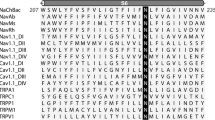Abstract
1. Two mutants of the sodium channel II have been expressed inXenopus oocytes and have been investigated using the patch-clamp technique. In mutant E387Q the glutamic acid at position 387 has been replaced by glutamine, and in mutant D384N the aspartic acid at position 384 has been replaced by asparagine.2. Mutant E387Q, previously shown to be resistant to block by tetrodotoxin (Noda et al. 1989), has a single-channel conductance of 4 pS, that can be easily measured only using noise analysis. At variance with the wild-type, the openchannel current-voltage relationship of mutant E387Q is linear over a wide voltage range even under asymmetrical ionic conditions.3. Mutant D384N has a very low permeability for any of the following ions: Cl−, Na+, K+, Li+, Rb+, Ca2+, Mg2+, NH4 + , TMA+, TEA+. However, asymmetric charge movements similar to the gating currents of the Na+-selective wild-type are still observed.4. These results suggest that residues E387 and D384 interact directly with the pathway of the ions permeating the open channel.
Similar content being viewed by others
Abbreviations
- TTX:
-
tetrodotoxin; Na+, sodium; K+, potassium;
- NFR:
-
normal frog Ringer
- HEPES:
-
N-2-hydroxylethyl piperazine-N′-2-ethanesulfonic acid
- EGTA:
-
ethyleneglycol-bis(β-amino-ethyl ether) N,N,N',N'-tetra acetic acid
- TEA:
-
tetraethylammonium
- TMA:
-
tetramethylammonium;I g , gating current; γ, single-channel conductance
References
Almers W (1978) Gating currents and charge movements in excitable membranes. Rev Physiol Biochem Pharmacol 82:96–190
Armstrong M, Bezanilla F (1973) Currents related to the gating particles of sodium channels. Nature (London) 242:459–461
Armstrong M, Bezanilla F (1977) Inactivation of the sodium channel. II. Gating current experiments. J Gen Physiol 70:567–590
Bezanilla F, Armstrong M (1977) Inactivation of the sodium channel. J Gen Physiol 70:549–566
Conti F, Stühmer W (1989) Quantal charge redistributions accompanying the structual transitions of sodium channels. Eur Biophys J 17:53–59
Conti F, Neumcke B, Nonner W, Stämpfli R (1980) Conductance fluctuations from the inactivation process of sodium channels in myelinated nerve fibres. J Physiol (London) 308:217–239
Conti F, Inoue I, Stühmer W (1984) Pressure dependence of sodium gating currents in the squid giant axon. Eur Biophys J 11:137–147
Dascal N (1987) The use ofXenopus oocytes for the study of ion channels. CRC Crit Rev Biochem 22:317–387
Guy HR, Conti F (1990) Pursuing the structure and function of voltage-gated channels. Trends Neurosi 13:201- 206
Hamill OP, Marty A, Neher E, Sakmann B, Sigworth FJ (1981) Improved patch-clamp techniques for high-resolution current recording from cells and cell-free membrane patches. Pflügers Arch 391:85–100
Heinemann SH, Conti F (1991) Non-stationary noise analysis and its application to patch clamp recordings. In: Rudy B, Iverson LE (eds) Methods in enzymology (In press)
Hille B (1984) Ionic channels of excitable membranes. Sinauer Sunderland, Mass
Methfessel C, Witzemann V, Takahashi T, Mishina M, Numa S, Sakmann B (1987) Patch clamp measurements on Xenopus laevis oocytes: currents through endogeneous channels and implanted acetylcholine receptor and sodium channels. Pflügers Arch 407:577–588
Noda M, Ikeda T, Kayano T, Suzuki H, Takeshima H, Kurasaki M, Takahashi H, Numa S (1986a) Existence of distinct sodium channel messenger RNAs in rat brain. Nature (London) 320:188–192
Noda M, Ikeda T, Suzuki H, Takeshima H, Takahashi T, Kuno M, Numa S (1986b) Expression of functional sodium channels from cloned cDNA. Nature (London) 322:826–828
Noda M, Suzuki H, Numa S, Stuhmer W (1989) A single point mutation confers tetrodotoxin and saxitoxin insensitivity on the sodium channel II. FEBS Lett259:213–216
Pusch M (1990a) Open-channel block of Na+ channels by intracellular Mg2+. Eur Biophys J 18:317–326
Pusch M (1990b) Divalent cations as probes for structure-function relationships of cloned voltage-dependent sodium channels. Eur Biophys J 18:327–333
Pusch M, Conti F, Stuhmer W (1989) Intracellular magnesium blocks sodium outward currents in a voltage-and dose-dependent manner. Biophys J 55:1267–1271
Pusch M, Noda M, Conti F (1991) Gating currents of a sodium-channel mutant with very low conductance. (abstr). Biophys J 59:25 a
Sigworth FJ (1977) Sodium channels in nerve apparently have two conductance states. Nature (London) 270:265–267
Sigworth FJ, Spalding BC (1980) Chemical modification reduce the conductance of sodium channels in nerve. Nature (London) 283:293–295
Spalding BC (1980) Properties of toxin-resistant sodium channels produced by chemical modification in frog skeletal muscle. J Physiol (London) 305:485–500
Stühmer W, Methfessel C, Sakmann B, Noda M, Numa S (1987) Patch clamp characterization of sodium channels expressed from rat brain cDNA. Eur Biophys J 14:131–138
Stühmer W, Conti F, Suzuki H, Wang X, Noda M, Yahagi N, Kubo H, Numa S (1989) Structural parts involved in activation and inactivation of the sodium channel. Nature (London) 339:597–603
Tejedor FJ, Catterall WA (1988) Site of covalent attachment of α-scorpion toxin derivatives in domain I of the sodium channel subunit. Proc Natl Acad Sci USA 85:8742–8746
Author information
Authors and Affiliations
Rights and permissions
About this article
Cite this article
Pusch, M., Noda, M., Stühmer, W. et al. Single point mutations of the sodium channel drastically reduce the pore permeability without preventing its gating. Eur Biophys J 20, 127–133 (1991). https://doi.org/10.1007/BF01561134
Received:
Accepted:
Issue Date:
DOI: https://doi.org/10.1007/BF01561134




